When the California Zephyr began operating, General Motors ran this ad saying that all three participating railroads had selected EMD locomotives to pull the train. But that wasn’t quite true.
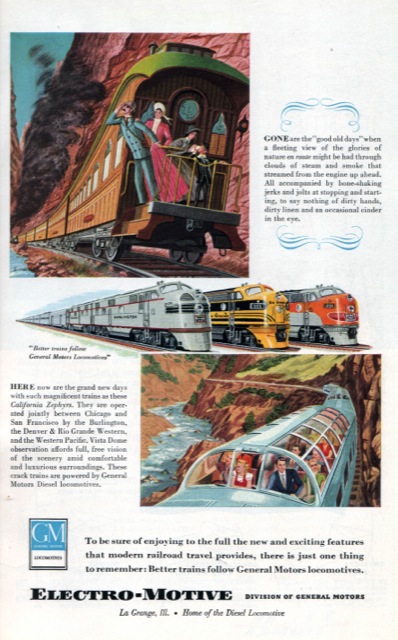
This ad appeared in the July, 1949 issue of National Geographic. Click image for a larger view.
The three railroads had calculated that they would need 4,500 horsepower to meet schedules with the planned 11-car (but sometimes longer) train. Two 2,000-HP E7 locomotives wouldn’t do it, but three 1,500-HP F3 locomotives would. So the Burlington and Western Pacific each bought F3s, which turned out to be the only F-series engines that the Burlington ever used in passenger service. (Even so, the Burlington sometimes used two E units to pull the California train.)
Burlington F3s pulling the California Zephyr through Galesburg, Illinois. Click image to download a PDF of this hand-colored postcard.
The Rio Grande, however, got into a tiff with General Motors over how the manufacturer calculated horsepower, and rather petulantly went to Alco instead. Alco made equivalents to GM’s F and E series but called them F and P series for freight and passenger. Instead of buying F-series Alcos to match the Burlington’s and WP’s Fs, Rio Grande bought the P series, which had built-in boilers for heating passenger cars. That meant it had to have three 2,000-HP locomotives per train, for a total of 6,000 horsepower.
Soon after the train began service, the Rio Grande bought some General Motors F locomotives for the California Zephyr after all–generally running four locos, for 6,000-HP–and the Alcos were often relegated to other trains. Apparently, the Rio Grande believed that its “through the mountains” route required more power than the other roads.
Western Pacific Fs in their distinctive orange dress pulling the California Zephyr across the Sierra Nevada. Click image to download a PDF of this postcard.
The Burlington painting its locomotives in its traditional silver with imitation-shovel-nose stripes used for all of its Zephyr trains, while the Western Pacific put a brilliant orange on the nose and side stripe of its otherwise silver-painted locomotives. The Rio Grande, however, apparently couldn’t decide on colors and ended up using four different locomotive paint schemes over the life of the train.
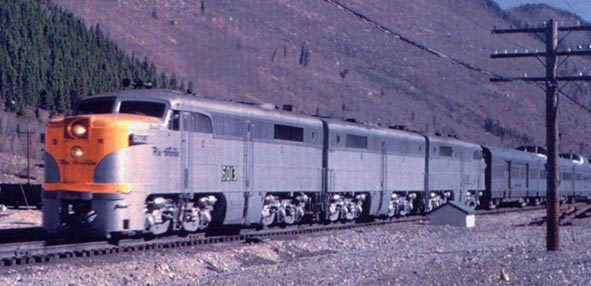
A rare color photo of the Rio Grande Alco locomotives in the aspen color scheme.
First came the “aspen” scheme, in which the Alco PA noses were painted bright yellow with the rest of the locomotive painted a flat grey that was probably supposed to look silver but didn’t. This scheme was never applied to General Motors locomotives.
Alcos in the black and yellow nose color scheme.
As shown in the GM ad above, the F3s were delivered in a black scheme with a yellow nose and yellow pinstripes. The Alcos were repainted in it as well. Unfortunately, mostly black really didn’t go with the bright colors associated with a silver train like the California Zephyr.
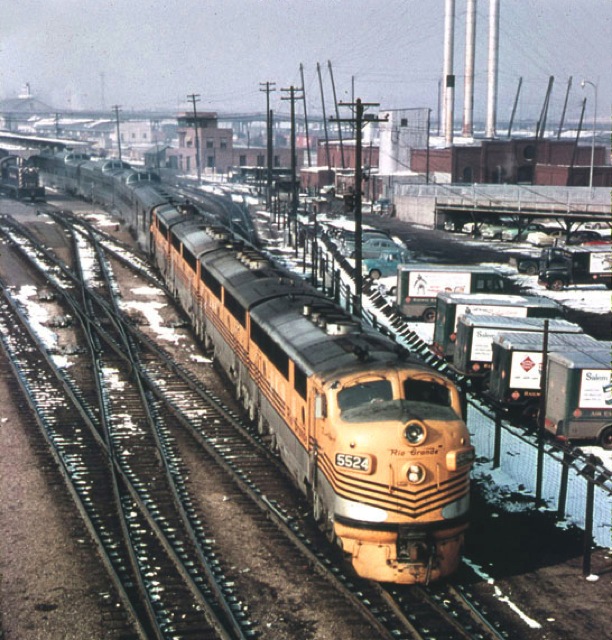
The California Zephyr, led by four Rio Grande F3s in the yellow color scheme, snakes its way through Denver.
With the third scheme, the Rio Grande finally got it right: yellow locomotives with black pinstripes and silver-grey lower bodies and roof. The yellow, which came to be known as “Grande gold,” was a much different shade from the Western Pacific’s orange, which was more like the Great Northern’s orange. The railroad painted both the Fs and the Alcos in this scheme; a few photos of Alcos in these colors show them hauling the California Zephyr, but most show them in front of other trains.
Four Rio Grande F3s in the simplified yellow color scheme pull the California Zephyr through Winter Park, Colorado. Click image to download a PDF of this postcard.
In the 1960s, the Rio Grande simplified the color scheme by turning the four black pinstripes into one stripe. Again, it painted both the Alcos and the F3s in this scheme, but by this time the Alcos were rarely, if ever used on the California Zephyr.
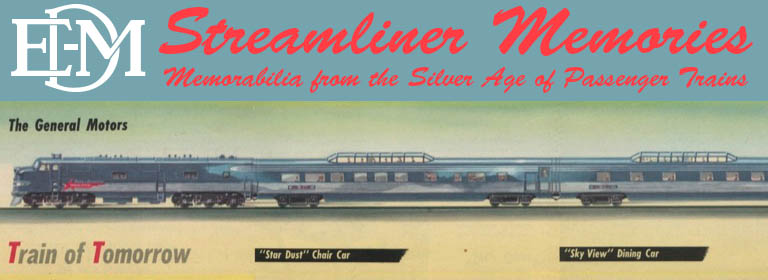
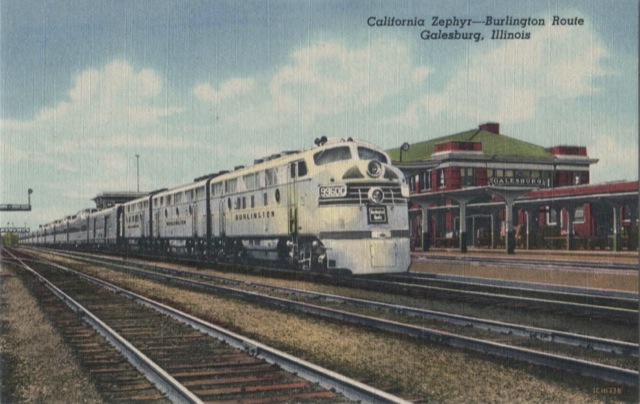
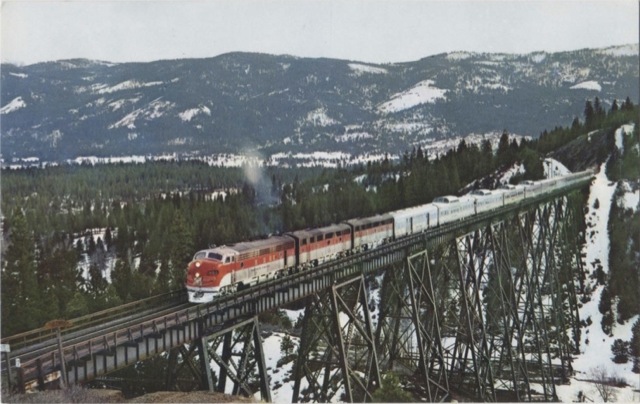
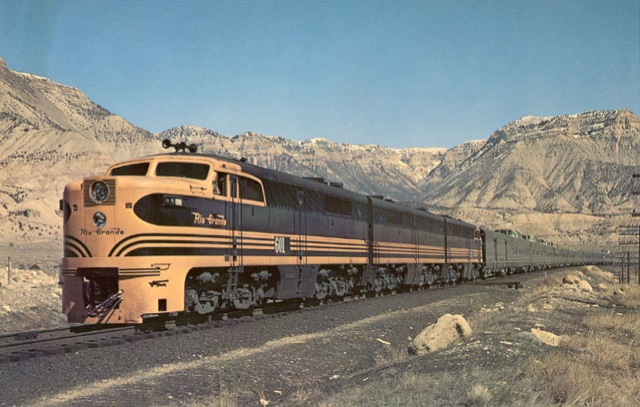
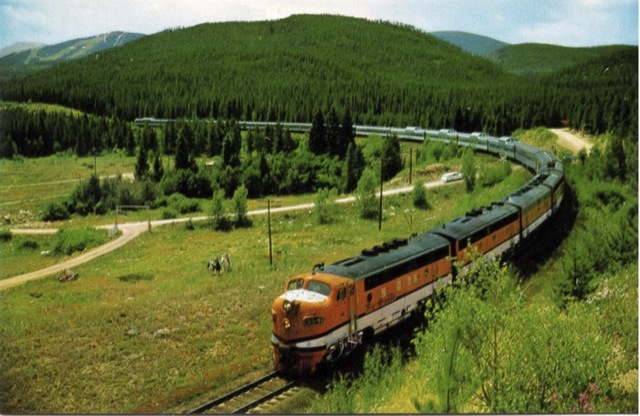
Actually, the Rio Grande PA locos were first delivered in the black and yellow, then painted (briefly) into the Aspen Gold and Silver scheme.